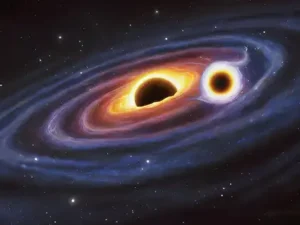GS3 – Science & Technology

Context
An international team of scientists has detected the largest black hole merger to date through gravitational wave observation, named event GW231123.
Understanding Gravitational Waves
- Gravitational waves are minute ripples in spacetime caused by massive accelerating bodies like colliding black holes.
- First predicted by Einstein in 1916, their existence was confirmed by LIGO in 2015.
- LIGO (US), along with Virgo (Italy) and KAGRA (Japan), forms the LVK collaboration, which detected this event.
- India’s own observatory, LIGO-India, is currently under construction in Hingoli, Maharashtra.
Black Holes and Mergers
- Black holes are formed when massive stars collapse under their own gravity.
- A black hole merger occurs when two such entities in a binary system spiral inward and unite, releasing intense gravitational waves in the process.
- Detection is made using laser interferometers, which pick up the faint vibrations in spacetime.
Details of the GW231123 Event
- Involved black holes of approximately 100 and 140 solar masses merging to form a remnant of 225–240 solar masses.
- This sets a new record, surpassing the earlier largest detected merger of ~140 solar masses.
- Scientific Anomaly: Both merging black holes lie in the pair-instability mass gap (~65–120 solar masses), where formation by stellar collapse is considered theoretically improbable.
- At least one black hole was spinning near the theoretical maximum, as per general relativity.
Scientific Significance
- Suggests that successive mergers (rather than direct stellar collapse) may explain the formation of supermassive black holes.
- Provides a unique opportunity to test the limits of Einstein’s General Relativity under extreme gravitational and rotational conditions.
- Offers valuable insights into black hole evolution and cosmic history, particularly in the early universe.




